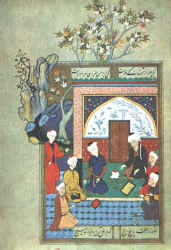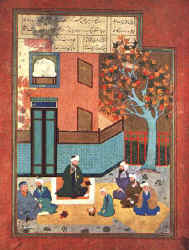|
|
|
Khodja
Akhmed Yasawi : Khodja Akhmed was born in Ispidjab (the modern town of Sairam) in 1103. Primarily he was educated by his father Sheikh Ibragim. Then Bakha ad-Din Ispidjabi, the well-known scientist from khanafid mazkhab was his tutor and spiritual master. Afterwards, he went to Otrar, to the famous Arystan Babu, the head of the local mubayydits. Khodja Akhmed Yasawi throughly adopted his teacher's spiritual and worldly wisdom. After the death of Arystan Babu Akhmed Khodja Yasawi moved to Bukhara, that was considered by the Muslims throughout the world as the Islam dome. Here he has found a worthy tutor for him in the person of the seminal figure of the period Sheikh Khodja Usuf Khamadani, the leader of the well-known school of mystics that believed they were destined to search for the unity with the spirit of Allah. Sufi Shaikhs called them upon this idea. Sufism appeared as a new mystic-ascetic trend in Islam. In Central Asia sufism was spread in IX-X centuries, and this fact was manifested in creation of Sufi schools belonging to different religious trends.These schools then began to unite in the orders headed by tutors, named in the Arab speaking countries as Sheikhs, in the Iran speaking countries as Sheikhs and Pyrs, and in Turkic speaking countries as Sheikhs, Pyrs, Ishans, Baba, Ata. The most common orders in Central Asia were: nakshbandyya, yasawyya, kurawyya.
Khodja Akhmed Yasawi was not only a religious figure, he was also the outstanding poet and philosopher. He subtly noticed various aspects of the existing reality. Everything arised his interest and attention: mundane life and destinies of the rulers, and the destiny of the whole nation. Being a wiser, he understood life in all its manifestations: external - as a thinker, and internal - as an ecclesiastic having relations to the High Spirit of Nature. The works of Khodja Akhmed Yasawi - poems, divans, risales - were widely popular among the local people. Sphere of his activities included not only spiritual tuition, he acted also as a wise statesman. In his sermons, poems, and treatises he responded to the topical questions when he had a feeling that could speak to people candidly. Khodja Akhmed Yasawi called upon people to be patient towards the representatives of other religions: If you meet the unfaithful, do not offend him. As legend says, Yasawi was forced to leave the fuss of the mundane life to serve to the Most High. He settled in the underground cell in the town of Yasy near the mosque ,where he stayed till his death.
The theological school created by Khodja Akhmed Yasawi was the centre attracting all people thirsty of knowledge and education. Thanks to the authority of this prominent person Turkistan turned into the most important medieval enlightening centre of Kazakhstan. After the death of the Sheikh the Sufi ecclesiastical centre Yasawyya that he had found out, continued its activities, and memorial complex erected near the grave became one of the most popular revered places throughout Central Asia. And this place of worship, as it had always been in the Muslim East, developed into the trade centre, oasis of handicrafts, spiritual life and cultural wealth. At the end of the XIV century by the command of Timur who worshipped Hodja Akhmed and made great efforts to glorify the memory of his spiritual master, the immense mausoleum was erected over the burial vault of Akhmed
Yasawi. |
|
Turkestan - 1500 |


